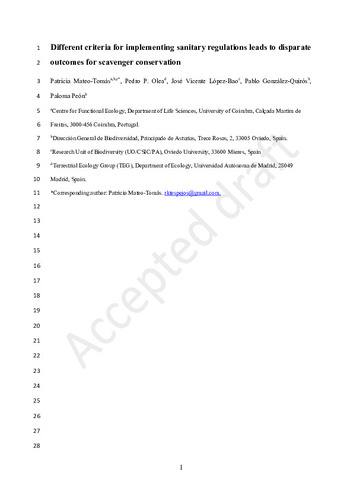Different criteria for implementing sanitary regulations lead to disparate outcomes for scavenger conservation
Autor(es) y otros:
Fecha de publicación:
Versión del editor:
Citación:
Descripción física:
Resumen:
1. Integrating environmental concerns into sectoral policies is a priority for sustain- able development. Despite environmental policy integration being established in Europe in 1998, major weaknesses still limit its effectiveness, such as poor coor- dination at national and subnational levels. 2. We use the integration of scavenger conservation into sanitary European regula- tions to illustrate how the adoption of different criteria when implementing the same legislation affects the effectiveness of the environmental policy integration process. We focus on the implementation across Spanish autonomous regions of Regulation EU 142/2011 allowing dead livestock to be left in situ for feeding scav- engers. Using Asturias (NW Spain) as a case study, we provide spatially explicit estimates of two key factors guiding the implementation of the legislation, the estimates of scavenger feeding requirements, and the area designated as scaven- ger feeding zones, based on different criteria used across Spanish regions. 3. We detected a remarkable variation in both scavenger feeding requirements (up to 452%; ranging from 108 to 596 t/year) and scavenger feeding zones (up to 72% in size) depending on the implementation criteria used. 4. The concentration of scavenger feeding requirements per km2 within scavenger feeding zones (i.e., carrion demand) varied up to 167%. Similarly, the concentra- tion of carrion supply from livestock within scavenger feeding zones (i.e., carrion availability) changed up to 33%. 5. Policy implications. Our results support the need for systematic evaluations to choose the best criteria for implementing sanitary regulations concerning scaven - ger conservation. Interregional coordination in implementing the agreed criteria emerges as a relevant issue to improve the effectiveness of environmental policy integration for transboundary conservation of European scavengers.
1. Integrating environmental concerns into sectoral policies is a priority for sustain- able development. Despite environmental policy integration being established in Europe in 1998, major weaknesses still limit its effectiveness, such as poor coor- dination at national and subnational levels. 2. We use the integration of scavenger conservation into sanitary European regula- tions to illustrate how the adoption of different criteria when implementing the same legislation affects the effectiveness of the environmental policy integration process. We focus on the implementation across Spanish autonomous regions of Regulation EU 142/2011 allowing dead livestock to be left in situ for feeding scav- engers. Using Asturias (NW Spain) as a case study, we provide spatially explicit estimates of two key factors guiding the implementation of the legislation, the estimates of scavenger feeding requirements, and the area designated as scaven- ger feeding zones, based on different criteria used across Spanish regions. 3. We detected a remarkable variation in both scavenger feeding requirements (up to 452%; ranging from 108 to 596 t/year) and scavenger feeding zones (up to 72% in size) depending on the implementation criteria used. 4. The concentration of scavenger feeding requirements per km2 within scavenger feeding zones (i.e., carrion demand) varied up to 167%. Similarly, the concentra- tion of carrion supply from livestock within scavenger feeding zones (i.e., carrion availability) changed up to 33%. 5. Policy implications. Our results support the need for systematic evaluations to choose the best criteria for implementing sanitary regulations concerning scaven - ger conservation. Interregional coordination in implementing the agreed criteria emerges as a relevant issue to improve the effectiveness of environmental policy integration for transboundary conservation of European scavengers.
ISSN:
Patrocinado por:
Spanish Ministry of Economy, Industry and Competitiveness, Grant/Award Number: RYC-2015-18932
Colecciones
- Artículos [37541]
- Biología de Organismos y Sistemas [776]
Ficheros en el ítem





